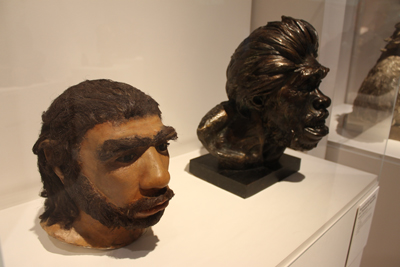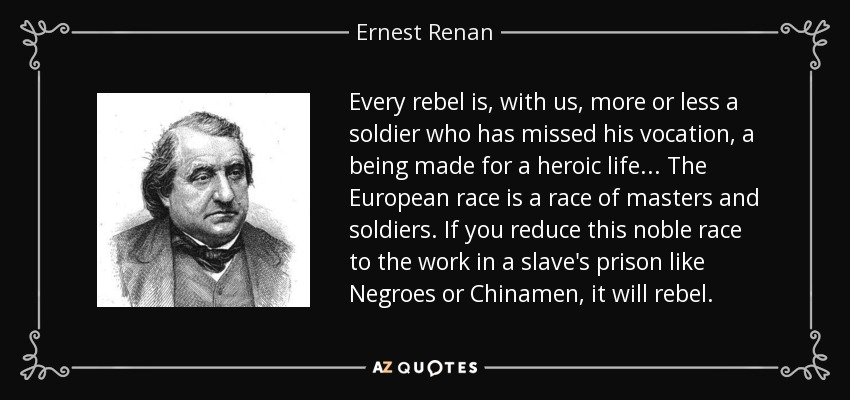Day 14 --
Tzvetan Todorov, On Human Diversity: Nationalism, Racism, and Exoticism in French Thought (Cambridge. Massachusetts: Harvard University Press, 1993, pp. 110-114.
The idea of the inequality of the human races is
a constant in Renan’s thinking, even if he does not always pay much
attention to it. This is because for him it goes without saying. "Men
are not equal; races not equal. The negro, for instance, is made to
serve the great enterprises that have been willed and conceived by the
white man" ( Philosophical
Dialogues and Fragments, p. xxix). And he imagines with horror what
would result from the opposite position: "The lack of sound regarding
the inequality of races may bring about a general debasement . . . .
Fancy what a spectacle the earth would have presented, had it peopled
solely with negroes, subordinating everything to individual enjoyment in
the midst of a general mediocrity" (pp. 36-37). [p.111]
not always pay much
attention to it. This is because for him it goes without saying. "Men
are not equal; races not equal. The negro, for instance, is made to
serve the great enterprises that have been willed and conceived by the
white man" ( Philosophical
Dialogues and Fragments, p. xxix). And he imagines with horror what
would result from the opposite position: "The lack of sound regarding
the inequality of races may bring about a general debasement . . . .
Fancy what a spectacle the earth would have presented, had it peopled
solely with negroes, subordinating everything to individual enjoyment in
the midst of a general mediocrity" (pp. 36-37). [p.111]
This vision of the races quite naturally entails
some practical consequences. In The Future of Science, Renan imagines an educational project that
retains some traces of the spirit of the Enlightenment (Helvetius or
Condorcet): "The scientific and experimental study of the education
barbarous races will become one of the most striking problems offered to
the mind of Europe" (p. 359). However, at roughly the same time, in
L'Origine du langage, a
different project is emerging, one that has to be recognized as
imperialistic : "Since the Aryan race and the Semitic race . . . are
destined to conquer the world and restore unity to the human species,
the rest of the world counts, alongside these races, only as
experiments, obstacles, or auxiliaries. (p115) . . .
Renan makes this vision somewhat more explicit in “La Re[/]forme
intellectuelle et morale de la France” [Intellectual and Moral Reform in
France]: “Nature created a race of laborers, the Chinese . . .; a race
[p.112] of field-workers, the Negroes . . . ; a race of masters and
soldiers European race" (p. 390). He conceives of a world state (the
master race would "restore unity to the human species") in which races
replace classes . . . Everything
is the work of nature; it is futile to protest. Humanity has no common
ideal; there are as. many models
for happiness as there are races. "The life that disgusts our workers
would make a Chinaman or a fellah
happy for these creatures are in no way military. Let everyone do the
work that he is intended to do, and all will be well" (p. 391). . . .
[pp.113]
Le Bon's position is distinguished by its
tendency to identify the hierarchy of race with the hierarchies of sex
and class (although Renan, was beginning to make the latter association,
as we have seen). There is no need to go to Africa to observe the
inferior races: we can simply study the workers at home. "The lowest
strata of the European cities are homologous with the primitive men" (The Psychology of Peoples, p. 29). "It would suffice . . . to allow
time to act to see the superior grade of a population separated
intellectually from the inferior grades by a distance as great as that
which separates the white man from the negro, or even the negro from the
monkey” (p.43). Within each
country, some part of the population does not lend itself to
civilization; Le Bon sees this threat hanging over the United States, a
country that has absorbed too many members of inferior races into its
work force.
And there is no need even to go to the factories or farms to see how primitive mentalities work: it suffices to go into the kitchen and take a [p.114] quick look at that inferior being who is your wife (Le Bon’s reader is necessarily male). Between the observer and the observed, then, there is "great mental separation . . . The man and the woman may have common interests and sentiments, but never like chains of thought. The difference in their logical faculties is alone sufficient to create between them an insuperable gulf ' (p. 36).We can see that, in Le Bon eyes, the civilized white man leads a dangerous life, surrounded as he is by so many abysses. The proof of female inferiority, and of the similarities between women and Negroes, is provided by craniology, another of Dr. Le Bon's specialties. White skulls are larger than black skulls -- but only in men; male skulls are larger than female skulls -- only in whites. "The average of the skulls of female Parisians classes, them among the smallest skulls with which we are acquainted, almost on a level with the skulls of Chinese women, and scarcely above the feminine skulls of New Caledonia" (p. 49). What else is there to say!
